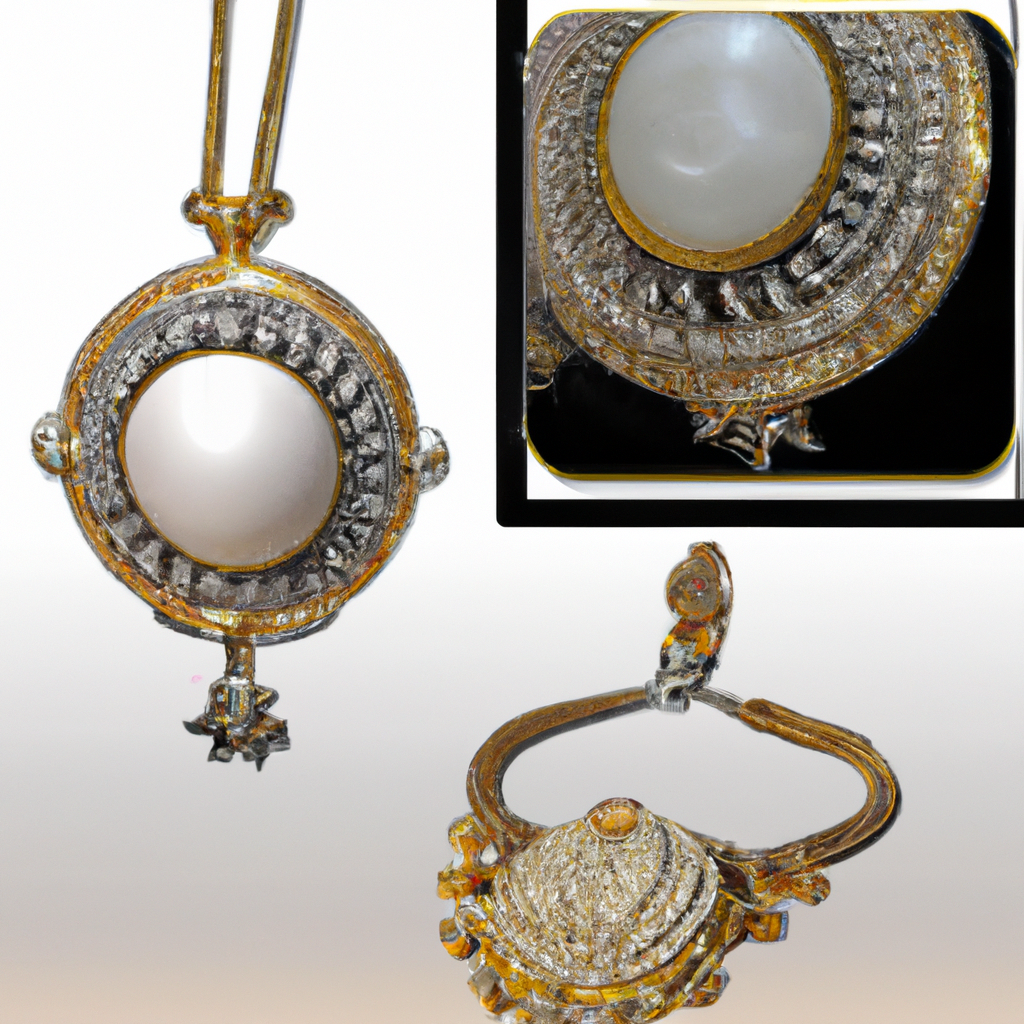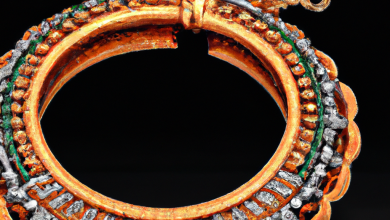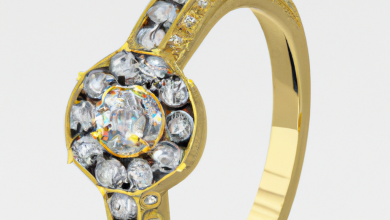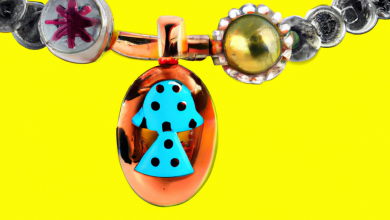
I. Introduction to the Art of European and American Jewelry
Jewelry has been an integral part of human culture for centuries, serving functional, religious, and decorative purposes. From early civilizations to modern times, jewelry has maintained its timeless charm and significance, symbolizing wealth, power, love, and self-expression.
The history of European and American jewelry dates back to the Middle Ages. During this period, jewelry was handcrafted from metals, semi-precious stones, and enamel to create intricate designs inspired by religion, mythology, and royalty. The Renaissance period marked a significant shift in jewelry-making, as artists and craftsmen embraced humanism and classical art to create exquisite pieces that reflected sophistication and elegance. The Baroque style was characterized by dramatic shapes, vivid colors, and intense religious symbolism, while the Rococo style focused on delicate forms, pastel hues, and ornate motifs.
The 19th century brought about significant changes in European and American jewelry. Queen Victoria’s reign influenced the Victorian era, characterized by romantic and sentimental designs, intricate details, and the use of pearls and gemstones. The Art Nouveau style, prevalent in the late 1800s, introduced flowing lines, nature-inspired forms, and the use of unconventional materials.
American jewelry has a unique and diverse cultural history. Native American jewelry, made from materials like turquoise, silver, and shell, reflected the traditional artistry and spirituality of the tribes. The Victorian era also influenced American jewelry, aligning with a growing middle-class customer base and the use of diamonds and precious metals. The Art Deco period of the 1920s and 30s introduced geometric shapes, bold colors, and a streamlined aesthetic to American jewelry.
Today, European and American jewelry has evolved to include a diverse range of styles, reflecting cultural and social changes. Modern jewelry incorporates traditional techniques with innovative designs and materials, catering to diverse customer preferences. The importance of sustainability and ethical practices in jewelry-making has also emerged, aligning with contemporary values and global trends.
In conclusion, the art of European and American jewelry has a rich and fascinating history. Its significance in human culture and society has endured the test of time, representing individuality, beauty, and cultural heritage.

II. European Jewelry: An Artistic and Historical Kaleidoscope
European jewelry has a rich and fascinating history that spans centuries of art and culture. During the Renaissance period, jewelry was viewed as a means of expressing one’s wealth and status. Courtiers and aristocrats adorned themselves with sumptuous jewelry that was often commissioned from famous artists and goldsmiths of the time. The Renaissance brought with it the revival of classical motifs, which were incorporated into jewelry designs, including cameo rings and pendants, intricate brooches, and earrings featuring birds and other animals.
The Baroque period in Europe, which spanned the 17th century, ushered in a new style of jewelry that was characterized by opulence, lavishness, and grandiosity. Baroque jewelry was marked by its ornate designs featuring a profusion of gemstones and pearls, and intricate shapes such as scrolls, leaves, and flowers. Jewelry pieces from this era were often handed down as family heirlooms, and they continue to be prized for their exquisite artistry and timeless elegance.
During the 18th century, the Rococo style of jewelry emerged in Europe. Rococo was characterized by its lightness, asymmetry, and delicate curving shapes. This style was popularized by the French monarch Louis XV and was marked by a preference for bright colors, playful patterns, and the use of semi-precious stones such as coral and turquoise. The era also saw the emergence of extravagantly designed hair ornaments, pendants, and earrings that featured intricate details and designs.
In the early 20th century, European jewelry witnessed a new era of innovation and artistic expression with the advent of Art Nouveau. This style was marked by its fluid, organic lines, and a preference for nature-inspired motifs, such as flowers, insects, and animals. The Art Nouveau movement revolutionized European jewelry design, with artists such as René Lalique, Georges Fouquet and Louis Comfort Tiffany producing iconic pieces that remain highly sought after today.
The jewelry designs of this era ushered in a new era of experimentation with materials, and gemstones such as opals, moonstones, and pearls were used more often in jewelry pieces. Art Nouveau jewelry remains a popular choice for collectors because it combines exquisite craftsmanship, intricate detailing, and an adherence to naturalistic motifs.
In conclusion, European history, culture, and art have had a significant impact on jewelry design. It has been a journey through time, a journey that allowed jewelry to be art, religion, culture, and ultimately a means of self-expression. European jewelry has a rich storytelling tradition and a testament to human creativity – one that offers an insight into what living in different cultures was like throughout time. Each era has left its mark on European jewelry, and even today, artists and designers continue to draw inspiration from the past and reinterpret it in their designs.
III. American Jewelry: A Fusion of Cultures and Styles
American jewelry has been influenced throughout the years by the various cultural and historical events that shaped the country. From the intricate and stunning pieces made by Native Americans to the more modern and contemporary designs of today, American jewelry has built its own unique identity.
Native American jewelry is a significant part of early American jewelry history. Often made with natural materials such as turquoise, coral, and silver, these jewelry pieces reflect the cultural and spiritual beliefs of the native tribes. Native American artisans used their creativity and craftsmanship to create beautiful and intricate pieces of adornment, ranging from necklaces and bracelets to earrings and rings. Today, Native American jewelry is still highly respected and sought after for its unique beauty and value.
During the Victorian era, American jewelry took on a more sentimental and romantic tone. Lockets, cameos, and brooches were popular items, often adorned with intricate designs and gemstones. The popularity of mourning jewelry also emerged during this time, featuring black enamel and mourning symbols such as urns and weeping willows. With the rise of the middle class, jewelry became more accessible and was no longer the exclusive privilege of the upper class.
The Art Deco period in the 1920s and 1930s brought a new era of American jewelry, characterized by geometric shapes, bold colors, and Art Deco motifs. Designs featured natural materials such as jade, onyx, and coral and popularized costume jewelry, affordable pieces made with less expensive materials.
The popularity of modern and contemporary American jewelry grew in the latter part of the 20th century. Jewelry artists like Alexander Calder and David Webb presented innovative and contemporary designs, reflecting the social and cultural changes of the times. Contemporary American jewelry is known for its balance between form and function, and its use of non-traditional materials such as plastic, rubber, and even recycled materials.
In conclusion, American jewelry has evolved and grown into a unique reflection of cultural and historical events, from the Native American influence to the contemporary and sustainable jewelry of today. Each era has contributed to American jewelry’s distinct identity, and it continues to inspire and influence designers around the world.
IV. Modern Jewelry: The Blend of Tradition and Innovation
In the present era, jewelry-making has grown into a highly innovative and technologically advanced craft, blending tradition with modernity. Innovation in this industry has significantly impacted the creativity and possibilities of jewelry. The evolution of European and American jewelry into modern times has been shaped by advancements in technology, culture, and fashion.
One of the significant influences of modern technology on jewelry is the use of computer-aided design (CAD) in crafting bespoke and customized jewelry. Through 3D modeling and rendering, jewelers can present accurate and realistic designs before actual production. CAD has influenced the production of intricate pieces that were once impossible to make, forging a new frontier for innovation.
Technology has also increased the speed and efficiency of production, reducing the time taken and improving accuracy. LASER (Light Amplification by Stimulated Emission of Radiation) technology has facilitated jewelry cutting, engraving, and marking. LASER technology has increased the level of precision, consistency, and speed of production, allowing for more complex designs.
The rise of sustainable and ethical jewelry is a significant trend in modern jewelry-making. The demand for ethical jewelry has grown in response to the environmental and social challenges that have arisen from mining and sourcing materials. Ethical jewelry makers prioritize sustainable methods of mining, sourcing, and production, ensuring a reduced carbon footprint and minimal environmental impact.
Sustainable jewelry also meets human rights standards and ensures fair working conditions and wages throughout the production process. Ethical jewelry makers strictly adhere to extremely high standards of social and environmental responsibility, and their jewelry remains critical in the fight against inhumanity and illegalities in the jewelry industry.
In conclusion, the blend of tradition and innovation has shaped European and American jewelry, with modern-day techniques changing the jewelry-making scene considerably. Jewelers now have a greater understanding of the craft and the ability to create intricate and bespoke designs through modern technology. Innovation in jewelry-making goes hand in hand with ethical and environmental practices, enabling sustainable and socially responsible production. With the continued rise of technology, jewelry-making is ever-evolving and will continue to be a dynamic and exciting industry.
V. The Future of European and American Jewelry: Trends and Predictions
The jewelry industry is constantly evolving, with new trends and techniques emerging every year. As we venture into the future, it’s essential to discern and predict the significant influences that may impact the evolution and direction of European and American jewelry.
The Influence of Fashion and Culture on Jewelry Trends
Fashion trends often dictate the direction of jewelry, and it’s no surprise that jewelry reflects the changing values and tastes of society. In recent years, the demand for eco-friendly, ethically-sourced, and sustainable jewelry has been on the rise, fueled by the growing awareness of environmental issues and the desire for conscious consumerism.
Moreover, pop culture influences jewelry trends, with celebrities wearing designer pieces that attract media attention and mass following. Social media has also become a platform where jewelry designers showcase their work, interact with their audience and receive feedback, allowing them to predict and anticipate trends.
The Rise of Personalization and Customization
Personalized and customized jewelry allows buyers to express their individuality while creating a sense of emotional connection with their pieces. It’s not a new concept, but in recent years, technology has made it more accessible, and new techniques have emerged for creating bespoke pieces.
Jewelry designers and makers now offer customizable options, from choosing the metal and stones to creating pieces based on one’s specifications and preferences. Engraving and customizing with names, initials, or dates also adds a personal touch.
The Possibility of New Materials and Techniques in Jewelry-making
As jewelry technology advances, new materials and techniques emerge that could fundamentally alter the jewelry industry. With technology, advancements in 3D printing and laser-cutting techniques offer new possibilities in jewelry-making.
Moreover, new materials now allow for creative possibilities in designing and manufacturing jewelry, such as precious metal clays, lab-grown diamonds, ethically-sourced gemstones, and alternative materials such as wood, resin, and ceramics. The introduction of these materials not only expands the design possibilities but also contributes to reducing the environmental impact of the industry.
In Conclusion
The future of European and American jewelry is promising, with new trends and technologies emerging to meet the needs and desires of consumers. As we advance, it’s important to remember the legacy and history of jewelry, preserving its cultural and artistic significance for generations to come. The jewelry industry has evolved from its early beginnings to become more sustainable, innovative, personalized, and inclusive, and it will continue to transform to better meet the ever-changing desires of society.
VI. Conclusion: Continuing the Legacy of European and American Jewelry
European and American jewelry are a testament to the artistry, creativity, and craftsmanship of its makers. The legacy of this jewelry has endured throughout history, and continues to inspire and captivate people today. As we look to the future, it is important to remember the importance of preserving the art, culture, and history of jewelry, and to continue to explore new ways to express ourselves through this timeless art form.
Preserving the art, culture, and history of jewelry is essential for future generations to understand and appreciate the significance and beauty of these objects. From the intricate designs and precious materials used in ancient times, to the advancements in technology and innovative techniques of today, jewelry has always reflected the values, beliefs and traditions of its makers and wearers. By preserving the history of jewelry, we can learn about the culture and social norms of different times and places, as well as appreciate the technical skills and artistic abilities of generations past.
Jewelry also plays a significant role in self-expression and personal identity. Whether it is a wedding band, a family heirloom, or a piece of custom-made jewelry, jewelry holds sentimental value and sentimental significance. Jewelry can reflect the personality of the wearer, their style, and even their beliefs. It is a way to express oneself without words, and to connect with others who share similar interests, values, and aesthetics.
The allure of European and American jewelry is enduring, and it will continue to be treasured for generations to come. From simple and elegant designs, to opulent and intricate pieces, European and American jewelry has captured the imagination of people around the world. With the rise in sustainability, ethical production, and innovative designs, the future of jewelry is exciting and promising.
In conclusion, the art of European and American jewelry is a journey through time and style that reflects the legacy of its creators and wearers. By preserving the art, culture, and history of jewelry, we can continue to enjoy and appreciate this timeless art form for generations to come. The role of jewelry in self-expression and personal identity will also endure, as people use it to express their individuality and connect with others. The enduring allure of European and American jewelry is a testament to its timeless beauty and value.



